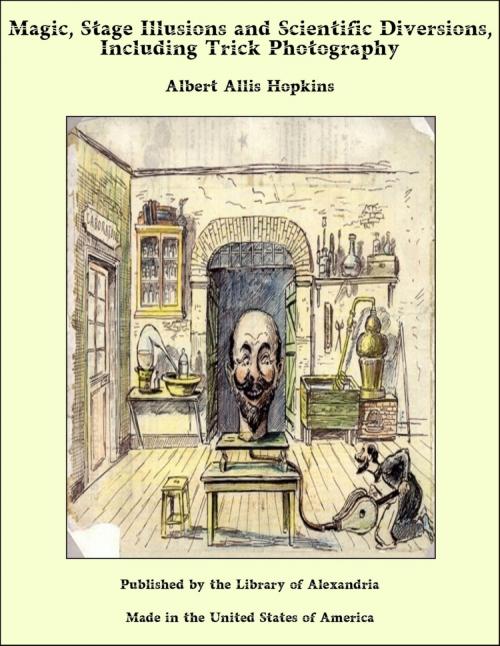Magic, Stage Illusions and Scientific Diversions, Including Trick Photography
Nonfiction, Religion & Spirituality, New Age, History, Fiction & Literature| Author: | Albert Allis Hopkins | ISBN: | 9781465614391 |
| Publisher: | Library of Alexandria | Publication: | March 8, 2015 |
| Imprint: | Language: | English |
| Author: | Albert Allis Hopkins |
| ISBN: | 9781465614391 |
| Publisher: | Library of Alexandria |
| Publication: | March 8, 2015 |
| Imprint: | |
| Language: | English |
Far back into the shadowy past, before the building of the pyramids, magic was a reputed art in Egypt, for Egypt was the “cradle of magic.” The magicians of Egypt, according to the Bible chronicle, contended against Aaron, at the court of Pharaoh. The Hebrew prophet “cast down his rod before Pharaoh and before his servants, and it became a serpent. Then Pharaoh also called the wise men and the sorcerers: now the magicians of Egypt, they also did in like manner with their enchantments. For they cast down every man his rod and they became serpents: but Aaron’s rod swallowed up their rods.” [Exodus vii. 10, 11, 12.] The late Robert Heller, prestidigitateur, traveler in the Orient, and skeptic, once told me that he had seen this feat performed in Cairo many times by the Dervishes. The rods actually were serpents and hypnotized to such an extent as to become perfectly stiff and rigid. When thrown upon the earth and recalled to life by sundry mystic passes and strokes, they crawled away alive and hideous as ever. Said Heller: “It was in the open air that I saw this strange feat performed. Transferred to the gloomy audience chamber of some old palace, where the high roof is supported by ponderous stone columns painted with hieroglyphics, where rows of black marble sphinxes stare at you with unfathomable eyes, where the mise en scène is awe-inspiring—this trick of the rods turning into serpents becomes doubly impressive, and indeed to the uninitiated a miracle.” In the British Museum is an Egyptian papyrus, which contains an account of a magical séance given by a certain Tchatcha-em-ankh before King Khufu, B.C. 3766. In this manuscript it is stated of the magician: “He knoweth how to bind on a head which hath been cut off, he knoweth how to make a lion follow him as if led by a rope, and he knoweth the number of the stars of the house (constellation) of Thoth.” The decapitation trick is thus no new thing, while the experiment performed with the lion, undoubtedly a hypnotic feat, shows hypnotism to be old.
Far back into the shadowy past, before the building of the pyramids, magic was a reputed art in Egypt, for Egypt was the “cradle of magic.” The magicians of Egypt, according to the Bible chronicle, contended against Aaron, at the court of Pharaoh. The Hebrew prophet “cast down his rod before Pharaoh and before his servants, and it became a serpent. Then Pharaoh also called the wise men and the sorcerers: now the magicians of Egypt, they also did in like manner with their enchantments. For they cast down every man his rod and they became serpents: but Aaron’s rod swallowed up their rods.” [Exodus vii. 10, 11, 12.] The late Robert Heller, prestidigitateur, traveler in the Orient, and skeptic, once told me that he had seen this feat performed in Cairo many times by the Dervishes. The rods actually were serpents and hypnotized to such an extent as to become perfectly stiff and rigid. When thrown upon the earth and recalled to life by sundry mystic passes and strokes, they crawled away alive and hideous as ever. Said Heller: “It was in the open air that I saw this strange feat performed. Transferred to the gloomy audience chamber of some old palace, where the high roof is supported by ponderous stone columns painted with hieroglyphics, where rows of black marble sphinxes stare at you with unfathomable eyes, where the mise en scène is awe-inspiring—this trick of the rods turning into serpents becomes doubly impressive, and indeed to the uninitiated a miracle.” In the British Museum is an Egyptian papyrus, which contains an account of a magical séance given by a certain Tchatcha-em-ankh before King Khufu, B.C. 3766. In this manuscript it is stated of the magician: “He knoweth how to bind on a head which hath been cut off, he knoweth how to make a lion follow him as if led by a rope, and he knoweth the number of the stars of the house (constellation) of Thoth.” The decapitation trick is thus no new thing, while the experiment performed with the lion, undoubtedly a hypnotic feat, shows hypnotism to be old.















